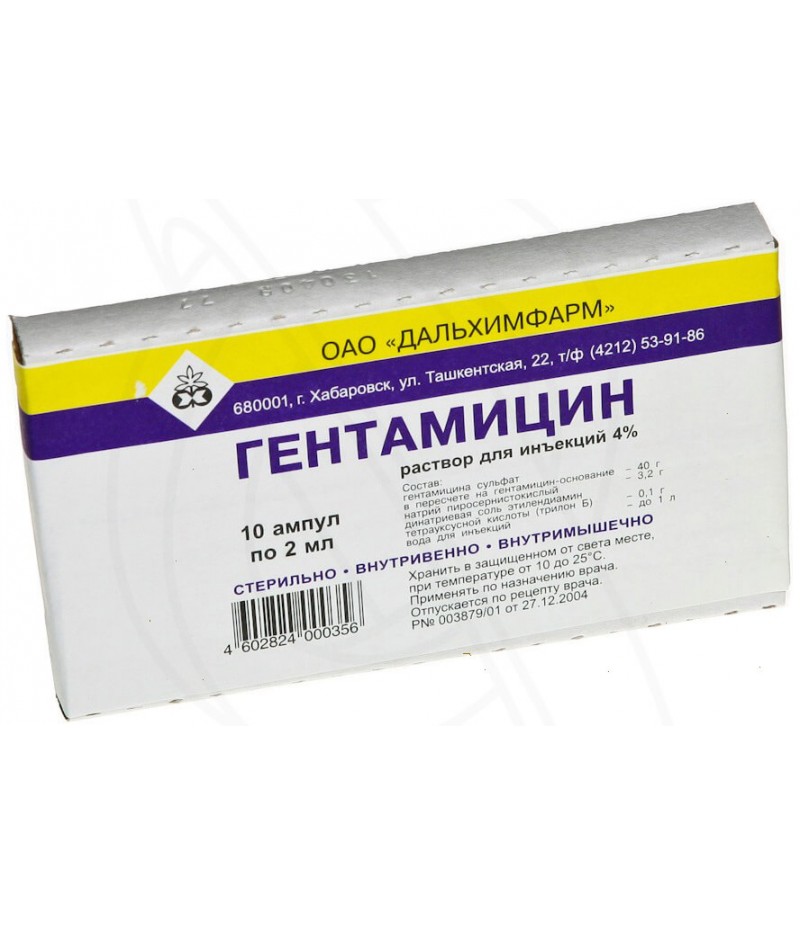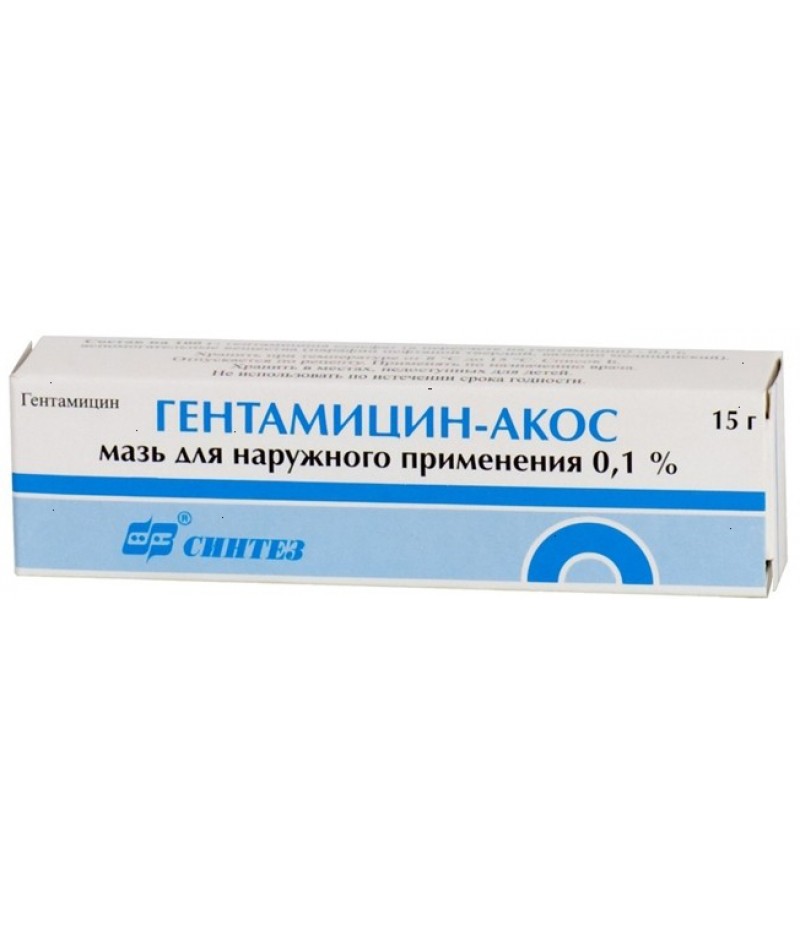Gentamicin for inj 20mg/ml 2ml #10
- $3.53
- 3 or more $3.46
- Availability:Out Of Stock
Gentamicin instructionReed more and buy Gentamicin for injections on this pageCompositionIn the solution for intravenous and intramuscular injection there is an active component of Gentamicin sulfate, as well as a number of additi..
Gentamicin instruction
Reed more and buy Gentamicin for injections on this page
Composition
In the solution for intravenous and intramuscular injection there is an active component of Gentamicin sulfate, as well as a number of additional components: sodium metabisulphite, disodium ethylenediaminetetraacetic acid salt, water.
Eye drops contain in the active ingredient Gentamicin sulfate, as well as additional components: sodium dihydrogen phosphate monohydrate, sodium chloride, sodium hydrophosphate dodecahydrate, benzalkonium chloride solution, water.
Form release Gentamicin
The drug is produced in several forms:
powder for the preparation of a solution, which is contained in vials;
4% solution in ampoules (ampoules of 1 and 2 ml) - a colorless or slightly colored transparent liquid;
eye drops 0,3% in tubes-droppers;
Gentamicin ointment for external use;
aerosol Gentamicin.
Gentamicin is not produced in tablets.
pharmachologic effect
Gentamicin is an antibiotic showing a wide range of effects, belongs to the group of aminoglycosides. In the body it binds to the 30S subunit of the ribosomes, as a result of which there is a violation of protein synthesis, the production of the transport and information RNA complex is suspended. Random reading of RNA is erroneous and non-functional proteins are formed. There is a bactericidal effect - under the condition of high concentrations of the substance reduces the barrier functions of cytoplasmic membranes, resulting in microorganisms perishing.
There is a high sensitivity to this antibiotic from some gram-negative microorganisms.
A sensitivity to the substance of a number of gram-positive microorganisms was also noted.
Resistance to the antibiotic is demonstrated by: Neisseria meningitidis, Providencia rettgeri, Clostridium spp., Treponema pallidum, Bacteroides spp., Streptococcus spp.
If Gentamicin is combined with penicillins, its activity is noted in relation to Enterococcus faecium, Enterococcus faecalis, Enterococcus avium, Enterococcus durans, Streptococcus faecium, Streptococcus durans, Streptococcus faecalis.
The resistance of microorganisms to this drug develops slowly, but those strains that demonstrate resistance to neomycin and kanamycin can also be resistant to gentamicin. On mushrooms, protozoa, viruses do not work.
Pharmacokinetics and pharmacodynamics
Immediately after intramuscular injection, the substance is rapidly and completely absorbed. The maximum concentration in the body after administration is intramuscularly achieved after 0.5-1.5 hours. After a 30-minute infusion intravenously - after 30 minutes, after a 60-minute infusion intravenously - after 15 minutes.
Plasma protein binds little - up to 10%. Therapeutic concentrations of the substance are found in the kidneys, liver, lungs, as well as in body fluids - peritoneal, ascitic, synovial, pericardial, pleural, lymphatic; is found in pus, separated by wounds, granulations, in the urine.
Low concentrations of the substance are observed in muscles, adipose tissue, breast milk, bile, bones, sputum, bronchial secretions, cerebrospinal fluid, eye moisture.
Through GEB in adult patients almost does not penetrate, through the placenta penetrates.
In cerebrospinal fluid, neonatal concentrations are higher than in adults.
Metabolism in the body is not affected. Elimination time in adults is 2-4 hours, in children up to 6 months - 3-3.5 hours.
The body is mainly excreted through the kidneys, unchanged, minor amounts of antibiotic are excreted with bile. If the kidney function in the patient is normal, then during the first day 70-95% of the substance is excreted. At the same time in the urine there is a concentration of more than 100 μg / ml. Cumulation is noted upon repeated administration.
Indications for use
Indications for the use of the drug are diseases of an infectious and inflammatory nature that were provoked by microorganisms sensitive to gentamicin.
Parenteral administration of the drug (4% solution) is indicated for such diseases:
pyelonephritis;
acute cholecystitis;
cholangitis;
cystitis;
pneumonia;
peritonitis;
empyema of the pleura;
ventriculitis;
sepsis, purulent lesions of soft tissues and skin;
infections due to wounds and burns;
infection of joints and bones.
Injections in gynecology are used in severe inflammatory processes.
Contraindications
Do not use this medication in such cases:
high sensitivity to this antibiotic and other aminoglycosides;
neuritis of the auditory nerve;
uremia;
impaired renal function in severe form;
pregnancy and feeding.
In the process of using this medication, it is necessary to periodically monitor the kidney function.
Side effects
In the process of admission, certain side effects can be noted:
digestive system: hyperbilirubinemia, nausea and vomiting, increased activity of "liver" transaminases;
hematopoiesis: leukopenia, anemia, thrombocytopenia, granulocytopenia;
nervous system: paresthesia, headache, muscle twitching, numbness, epileptic seizures, drowsiness; possibly the manifestation of psychosis in children;
sensory organs: noise in the ears, hearing impairment, labyrinthine and vestibular disorders, deafness;
urination: nephrotoxicity with impaired renal function, rarely - renal tubular necrosis;
allergies: rash on the skin, fever, itching, eosinophilia, angioedema;
laboratory indicators: hypokalemia, hypocalcemia, hypomagnesemia in children;
other manifestations: superinfection.
Instructions for use Gentamicin (Method and dosage)
Gentamicin sulfate should be used, given the localization of infection, the severity of the disease, the sensitivity of the pathogen.
Gentamicin injections, instructions for use
Before the start of treatment it is recommended to carry out a determination of the sensitivity of the microflora to gentamicin.
The drug in ampoules when administered intravenously or intramuscularly to adults is indicated in a dose of 1.7 mg per kg of body weight. The dose per day is 3-5 mg per kg of body weight. You need to administer the medicine 2-4 times a day. Treatment lasts from 7 to 10 days. For intramuscular injection, powder is also used, previously adding 2 ml of distilled water to the ampoule.
Gentamicin, depending on the disease, can also be used in a dose of 120-160 mg once a day for 7-10 days or in a dose of 240-280 mg once.
Introduction intravenously practice for 1-2 hours.
Children are prescribed this medicine only for severe infectious diseases. Newborn babies and premature infants receive a daily dose of 2-5 mg per kg, the drug is administered twice a day.
Children under 2 years receive the same dose per day, the drug is administered three times a day.
Children after 2 years receive a daily dose of 3-5 mg per kg, the drug is administered three times a day.
Patients with impaired renal function need to adjust the dose.
The maximum dose per day for children and adults is 5 mg per kg of body weight.
Overdose
In case of an overdose of Gentamicin in ampoules or other forms of medication, a decrease in neuromuscular conduction may be noted up to the stopping of breathing.
In case of overdose, adult patients should be given anticholinesterase medications (Prozerin), calcium preparations. Before the introduction of proserin, the patient is administered 0.5-0.7 mg of Atropine intravenously, wait until the pulse is increased, after which prozeryn is administered at a dose of 1.5 mg. If there is no effect after the administration of such a dose, the same amount of prosirin is administered repeatedly. With the development of bradycardia, an additional injection of atropine is done.
When an overdose in children requires the introduction of potassium preparations. Gentamicin is excreted from the body by hemodialysis and peritoneal dialysis.
Interaction
If injections of Gentamicin or the use of other forms of medication are practiced simultaneously with Vancomycin, aminoglycosides, cephalosporins, ethacrynic acid, oto- and nephrotoxic effects may be exacerbated.
If the drug is used with indomethacin, the clearance of Gentamicin decreases, its concentration in the blood increases and, accordingly, the toxic effect increases.
When Gentamicin is used with opioid analgesics, preparations for inhalation anesthesia increase the likelihood of neuromuscular blockade, possibly the development of apnea.
The concentration of gentamicin in the blood increases, if taken simultaneously with the "loop" diuretics.
Storage conditions
Keep away from light, store Gentamicin at a temperature of up to 25 ° C.
Shelf life - 4 years.
special instructions
Carefully apply this medicine to people who suffer from myasthenia gravis, parkinsonism, impaired renal function. In people with impaired renal function, as well as with prolonged intake of large doses of the agent, the risk of developing nephrotoxicity increases. During the treatment it is important to monitor the condition of the vestibular and hearing aids, the function of the kidneys. It is also important to determine the condition of the hearing. If the audiometric tests are unsatisfactory, the treatment is discontinued.
It should be borne in mind that with prolonged use of the drug externally, a resorptive effect is possible, from which Gentamicin Acos ointment and other forms of the drug should be externally applied controlled.
Due to the presence of sodium bisulfite in the solution in ampoules, the probability of developing allergic manifestations increases, especially in people with an allergic anamnesis.
People who take medicine for the treatment of infectious-inflammatory diseases of the urinary tract, it is recommended to drink a lot of fluid during the treatment.
In the process of therapy, the development of resistance of microorganisms is possible.
Children
Children of early age are prescribed a remedy only for their vital indications. It is important to adhere to the prescribed treatment regimen and ensure that the doctor is supervised of the patient's condition.
In pregnancy and lactation
During pregnancy, Gentamicin can not be used. It is also not recommended to take the medication during breastfeeding. It is noted that aminoglycosides enter breast milk in small amounts. But they are not absorbed from the digestive system, so complications were not recorded in infants.
Reviews about Gentamicin
Most of the reviews indicate the effectiveness of this tool. Reviews of Gentamicin in pricks are written by those to whom the drug helped cope with various diseases. Users mention that when taking injections sometimes develop side effects - most often it's nausea, headaches, drowsiness, hearing impairment. Also, users note that the injection of injections can be painful. As a positive moment, the low price of the medicine is mentioned.


